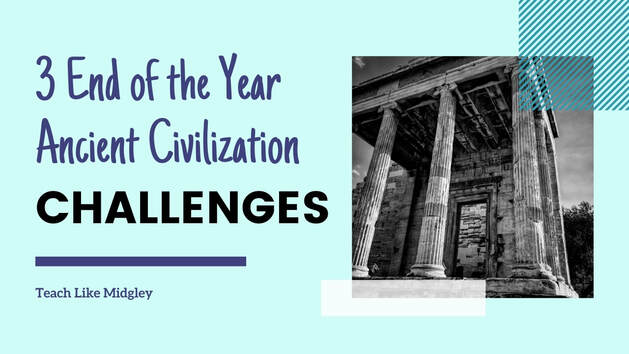3 End of the School Year Challenges for Your Ancient Civilizations Curriculum
The end of the school year is finally approaching. It’s hard to believe the time is finally here.
Your school year has been a roller coaster of a ride. You are exhausted and excited for the end to finally be here.
You are about to wrap up the final unit of your ancient civilization curriculum, and the calendar tells you there is about another week of lessons to prepare.
You want to do something fun with your students to celebrate the conclusion of your studies. But the thought of one more STEM or STEAM activity just makes you want to cry...
Your energy is limited. You don’t have the time or desire to gather up tons of art supplies and materials so your students can complete some fancy project.
I know that feeling all too well. Which is why I decided to find a way to wrap-up my school year with a series of challenges that would put my students’ knowledge to the test in a fun, engaging, and non-project way.
In this post I’m going to share with you three challenges to present your students that aligns perfectly with your ancient civilizations curriculum.
Your school year has been a roller coaster of a ride. You are exhausted and excited for the end to finally be here.
You are about to wrap up the final unit of your ancient civilization curriculum, and the calendar tells you there is about another week of lessons to prepare.
You want to do something fun with your students to celebrate the conclusion of your studies. But the thought of one more STEM or STEAM activity just makes you want to cry...
Your energy is limited. You don’t have the time or desire to gather up tons of art supplies and materials so your students can complete some fancy project.
I know that feeling all too well. Which is why I decided to find a way to wrap-up my school year with a series of challenges that would put my students’ knowledge to the test in a fun, engaging, and non-project way.
In this post I’m going to share with you three challenges to present your students that aligns perfectly with your ancient civilizations curriculum.
Why Choose Challenges
Some teachers are artsy, crafty, and team hands-on projects all the way. Let me just say, that is amazing – keep being AWESOME!
But that is just not me. I am not the artsy, crafty teacher. The idea of project chaos makes me queasy. No joke.
I do like having fun with my students. And I really like projects that challenge their minds more than their artistic talents.
What better way to have some fun, than with a curriculum we have spent all year learning?
While you may have done some compare and contrasting with your units on ancient India and China, or even with ancient Greece and Rome, for the most part you probably taught your units in isolation. Of course there was some overlap, like when Alexander the Great conquers Egypt followed by Rome. But I think you get my point.
The end of the year is the perfect time to really compare and analyze all the different societies that have been studied.
Sure, you could do this with hands-on, crafty projects. But you don’t have to. And that’s what this post is all about.
Because not all teachers are crafty (myself included here) but I think it’s also important to recognize that not all students are crafty either.
So whether you want to go whole class, or simply add these options to a choice board for your non-crafty students, either way they are great challenges! I have had so much fun with my students with these lessons.
But that is just not me. I am not the artsy, crafty teacher. The idea of project chaos makes me queasy. No joke.
I do like having fun with my students. And I really like projects that challenge their minds more than their artistic talents.
What better way to have some fun, than with a curriculum we have spent all year learning?
While you may have done some compare and contrasting with your units on ancient India and China, or even with ancient Greece and Rome, for the most part you probably taught your units in isolation. Of course there was some overlap, like when Alexander the Great conquers Egypt followed by Rome. But I think you get my point.
The end of the year is the perfect time to really compare and analyze all the different societies that have been studied.
Sure, you could do this with hands-on, crafty projects. But you don’t have to. And that’s what this post is all about.
Because not all teachers are crafty (myself included here) but I think it’s also important to recognize that not all students are crafty either.
So whether you want to go whole class, or simply add these options to a choice board for your non-crafty students, either way they are great challenges! I have had so much fun with my students with these lessons.
Challenge #1
I always start my challenges in the exact same place I start every other unit I teach: Location. Where in the world are these ancient civilizations?
Throughout the year, my students take Map Tests that are designed around the geography and present-day countries of where each ancient civilization was located. It seems only fitting that there be a culminating Map Test style challenge that addresses the location of all our units of study.
It’s also fun to include the geographic feature that made this location ideal to providing a reliable food source. Because of course, at the foundation of every civilization is the ability to build a permanent settlement because people were able to farm.
Throughout the year, my students take Map Tests that are designed around the geography and present-day countries of where each ancient civilization was located. It seems only fitting that there be a culminating Map Test style challenge that addresses the location of all our units of study.
It’s also fun to include the geographic feature that made this location ideal to providing a reliable food source. Because of course, at the foundation of every civilization is the ability to build a permanent settlement because people were able to farm.
Challenge #2
This is where we kick it up a notch. In Challenge #2 we start comparing different aspects of the civilizations we’ve studied.
Everything from religion, to social structure, achievements, and government. The questions are based around the 7 part structure that I use to teach my ancient civilization curriculum all year long.
Which civilizations practiced a polytheistic form of religion?
Which civilizations were all governed by a monarch at some point in history?
I usually divide students up into groups to have discussions about these questions. While I require them to spend the first 15 minutes in discussion and using only their brains, when that time is up, I allow them to pull out their notebooks to help them.
Since we use our notebooks all year long, they are full of good information about the 7 parts for each civilization we’ve studied. We actually fill two notebooks (one each semester) and I tell students to keep their first notebook for the end of the year challenge. Since I talk it up a bit, they are super excited about it and I always have students bring both notebooks at the end of the school year for this project.
I absolutely LOVE watching them eagerly pull out their notebook and flip through to find that one section that proves the point to their group members.
Everything from religion, to social structure, achievements, and government. The questions are based around the 7 part structure that I use to teach my ancient civilization curriculum all year long.
Which civilizations practiced a polytheistic form of religion?
Which civilizations were all governed by a monarch at some point in history?
I usually divide students up into groups to have discussions about these questions. While I require them to spend the first 15 minutes in discussion and using only their brains, when that time is up, I allow them to pull out their notebooks to help them.
Since we use our notebooks all year long, they are full of good information about the 7 parts for each civilization we’ve studied. We actually fill two notebooks (one each semester) and I tell students to keep their first notebook for the end of the year challenge. Since I talk it up a bit, they are super excited about it and I always have students bring both notebooks at the end of the school year for this project.
I absolutely LOVE watching them eagerly pull out their notebook and flip through to find that one section that proves the point to their group members.
Challenge #3
In the third part of the challenge, students get the opportunity to create a MASTER Civilization.
Again, this challenge is based on the 7 part structure that I use to teach students my curriculum all year long. Which means they are very familiar with each aspect I am asking them to analyze.
Working in small groups, students discuss which civilization was the BEST in each of the particular civilization parts.
Who had the best location? Why? What made it the best?
Who had the best government? Why? What made it the best?
You can imagine the heated discussions that come from these questions. It is thrilling as a teacher to watch your students become passionate about their opinions and look for ways to justify their answers.
After analyzing, discussing, and choosing the best for each of the 7 parts, students are then left with a MASTER CIVILIZATION.
Again, this challenge is based on the 7 part structure that I use to teach students my curriculum all year long. Which means they are very familiar with each aspect I am asking them to analyze.
Working in small groups, students discuss which civilization was the BEST in each of the particular civilization parts.
Who had the best location? Why? What made it the best?
Who had the best government? Why? What made it the best?
You can imagine the heated discussions that come from these questions. It is thrilling as a teacher to watch your students become passionate about their opinions and look for ways to justify their answers.
After analyzing, discussing, and choosing the best for each of the 7 parts, students are then left with a MASTER CIVILIZATION.
Ready To Roll Materials
Now you know how you can challenge your students with your ancient civilization curriculum without being forced to make it an artsy type of project.
Talk it up to your students and tell them you have the ultimate CHALLENGE for them. I think it’s important to show how intellectual challenges can be fun.
The best part, is that every student can participate no matter what level they are at. Your more advanced students will have more complex explanations for their choices. While your lower level learners will still get to share their favorites and use their notebooks to help them.
You can create your own challenge materials, or if you are looking for a done-for-you solution, you can purchase mine! Head on over to my Teachers Pay Teachers store for my Ancient Civilization End of the Year Challenge Pack that includes all 3 of the challenges in this post. Enjoy and have fun!
Talk it up to your students and tell them you have the ultimate CHALLENGE for them. I think it’s important to show how intellectual challenges can be fun.
The best part, is that every student can participate no matter what level they are at. Your more advanced students will have more complex explanations for their choices. While your lower level learners will still get to share their favorites and use their notebooks to help them.
You can create your own challenge materials, or if you are looking for a done-for-you solution, you can purchase mine! Head on over to my Teachers Pay Teachers store for my Ancient Civilization End of the Year Challenge Pack that includes all 3 of the challenges in this post. Enjoy and have fun!
You May Also Like...
Let's Connect...

Welcome! I'm Hillary Midgley, a veteran 6th grade teacher.
I create educational materials and develop curriculum for other teachers. I specialize in teaching students how to learn through my Study Skills Curriculum. I have established fundamental classroom systems and structures for teachers to help them streamline their classroom. And my passion is teaching ancient history through engaging activities with foundations in academic skills. Here you will find resources on all of these topics and more. Learn more about me here.
|








